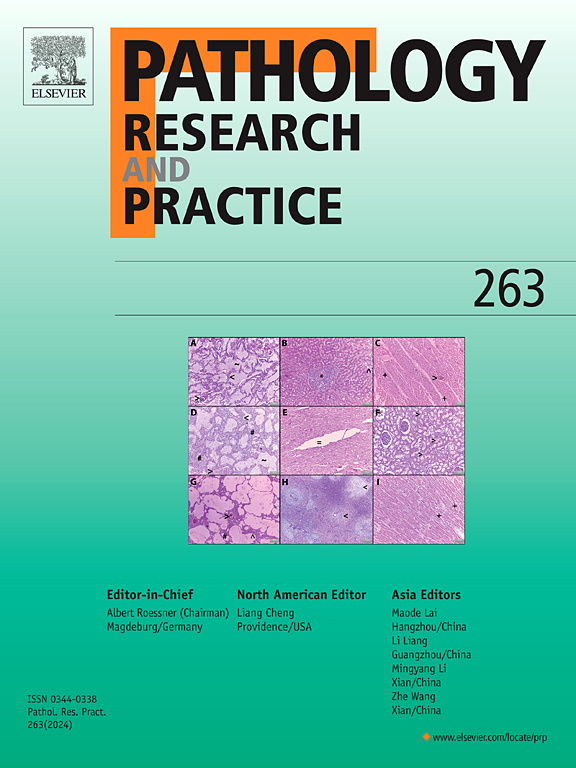FOXP3 is a favourable prognostic indicator in oesophageal adenocarcinoma
IF 3.2
4区 医学
Q2 PATHOLOGY
引用次数: 0
Abstract
Introduction
Oesophageal Adenocarcinoma (OAC) is a cancer with poor prognosis although multimodal treatment has greatly improved clinical outcomes for certain patients. However, currently, there is no way to predict which patients will benefit from neoadjuvant regimens. The level of immune cell tumour infiltration has shown prognostic ability in other cancer types. This study aimed to define the immune landscape of OAC tumours and describe interactions with clinicopathological parameters.
Methods
Three micron sections from n = 135 treatment-naïve OAC biopsies were stained using multiplex immunofluorescence for immune markers CD8, CD3, FOXP3, HLA-DR, CD68 and CD163. Expression of the immune markers in the tumour and stroma compartments and other pathological markers such as tumour buds (TB), poorly differentiated clusters (PDCs) and the tumour stroma ratio (TSR) were quantified by digital pathology software and the ability of each marker to predict patient clinical outcomes was investigated.
Results
On log-rank analysis stromal expression of FOXP3, CD68 and CD163 and tumour expression of FOXP3 and CD163 were all associated with improved OS (Log-rank p = 0.003, p = 0.0009, p = 0.003, p = 0.015, p = 0.039). PDCs were associated with worse OS (p = 0.039). Multivariate analysis identified tumour expression of FOXP3 as an independent favourable prognostic factor for OS (HR = 0.398, 95 % CI: 0.178–0.887, p = 0.024).
Discussion/Conclusion
Stromal expression of CD68, CD163 and FOXP3 and tumour expression of FOXP3 and CD163 were associated with improved outcome while the presence of PDCs was associated with worse outcome. FOXP3 was found to be an independent favourable prognostic factor, highlighting the need to better understand the role of FOXP3 in OAC.
FOXP3是预测食管癌预后的良好指标。
导语:食管癌(OAC)是一种预后较差的癌症,尽管多模式治疗对某些患者的临床效果有很大改善。然而,目前还没有办法预测哪些患者将从新辅助治疗方案中受益。免疫细胞肿瘤浸润水平在其他癌症类型中显示预后能力。本研究旨在定义OAC肿瘤的免疫景观,并描述与临床病理参数的相互作用。方法:对n = 135 treatment-naïve OAC活检组织3微米切片进行多重免疫荧光染色,检测免疫标志物CD8、CD3、FOXP3、HLA-DR、CD68和CD163。通过数字病理软件量化肿瘤和间质室中免疫标记物的表达以及肿瘤芽(TB)、低分化簇(PDCs)和肿瘤间质比(TSR)等其他病理标记物的表达,并研究每种标记物预测患者临床结局的能力。结果:log-rank分析基质FOXP3的表达,CD68 CD163和肿瘤的表达FOXP3 CD163都与改进操作系统(log-rank p = 0.003,p = 0.0009,p = 0.003,p = 0.015,p = 0.039)。PDCs与较差的OS相关(p = 0.039)。多因素分析发现FOXP3的肿瘤表达是OS的独立预后有利因素(HR = 0.398, 95 % CI: 0.178-0.887, p = 0.024)。讨论/结论:CD68、CD163和FOXP3的基质表达以及FOXP3和CD163的肿瘤表达与预后改善相关,而PDCs的存在与预后恶化相关。FOXP3被发现是一个独立的有利预后因素,强调需要更好地了解FOXP3在OAC中的作用。
本文章由计算机程序翻译,如有差异,请以英文原文为准。
求助全文
约1分钟内获得全文
求助全文
来源期刊
CiteScore
5.00
自引率
3.60%
发文量
405
审稿时长
24 days
期刊介绍:
Pathology, Research and Practice provides accessible coverage of the most recent developments across the entire field of pathology: Reviews focus on recent progress in pathology, while Comments look at interesting current problems and at hypotheses for future developments in pathology. Original Papers present novel findings on all aspects of general, anatomic and molecular pathology. Rapid Communications inform readers on preliminary findings that may be relevant for further studies and need to be communicated quickly. Teaching Cases look at new aspects or special diagnostic problems of diseases and at case reports relevant for the pathologist''s practice.

 求助内容:
求助内容: 应助结果提醒方式:
应助结果提醒方式:


